Aerial groups / widebands
What is a wideband aerial ?
What is a grouped aerial ?
Is there a significant difference?
For the answers read on.....
Including :
Wideband V Grouped gain graph
T Groups
A group signals travel further!
Identifying a wideband aerial incl:
- Director sizes of grouped Yagi aerials
Evolution of British TV aerial groups
Note : in this article a channel number (CH) refers to a frequency not a channel as in, say, BBC1.
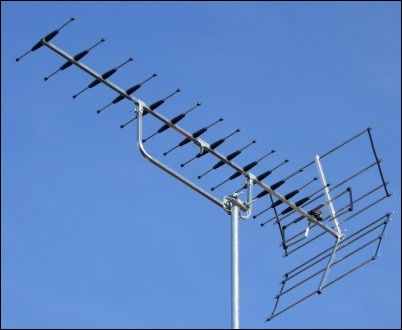
Although the TV UHF broadcast band in this country now only goes up as far as CH48 it used to stretch from 471 MHz (= CH21) at the bottom, to 847 MHz (= CH68) at the top. Now anyone who knows anything about RF (Radio Frequency) will tell you that it is asking a great deal of an aerial to perform well across such a wide frequency band, so, to get around this, when UHF TV transmissions were introduced in the mid 60s, great care was taken to minimise reception problems by utilising grouped transmitters and receiving aerials. That is to say all the the broadcasts from any particular transmitter were fitted into one group of frequencies, stretching across about one third of the full band. For example Crystal Palace transmitter is an A group. The groups are shown in the table below. Note that the groups have changed slightly over the years, though these apparently minor changes can sometimes be significant.
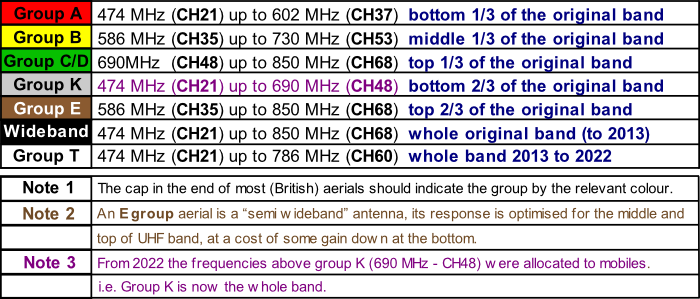
And where the top of the (ex) TV spectrum has gone.....
Graphic courtesy of DTG - July 2022

Director sizes of grouped Yagi aerials.
Note the coloured “bungs” in the ends of the booms, they are to denote the group of the aerial. If an aerial has a coloured bung it is a grouped type. On the other hand the vast majority of aerials with a black bung are widebands, but not all of them, particularly with foreign made aerials, they don't follow the conventional bung colour scheme so consistently.
Also see element sizes of an amateur radio array. [link]
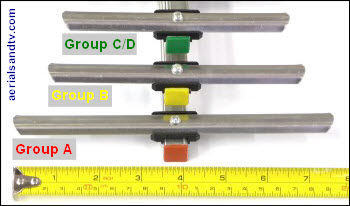
If one looks closely at the various grouped aerials one can see that the elements become smaller as the frequency rises and the wavelength shortens. The clearest example of this are amateur radio antenna arrays linked to above. Thus it can be appreciated how an aerials gain is not just down to the number of elements or its length the most important factor is the “tuning” of the elements. This is why an A group aerial (no matter how high its gain) will not receive the “out of band” frequencies.
It will be noted that the element for the A group is the longest because it is designed to be resonant with the lowest frequencies, which have the longest wavelengths. Incidentally the directors may all look the same size but in a correctly “tuned” antenna they can vary, for example the Yagi18A directors come in five different sizes, from 19.8cm at the front, up to 22.2cm at the back (with a 24.6cm [OD] dipole). At the higher end of the TV frequency band the wavelengths are that much shorter, and therefore the dimensions of the elements for a Yagi18C/D are (or were....) 14.0cm and 16.0cm (dipole 16.3cm) respectively.
Wideband aerials tend to use C/D length directors and an A group size dipole.
It should be noted that lower frequency signals - e.g. A group signals - travel through the air (or a roof) more efficiently than higher frequency signals - e.g. C/D group signals.
Some correspondence on the MB21 E Mail list concluded that an A group signal at 500MHz (=@ CH24) would lose about 4dB less, over 20 miles, than a C/D group one at 750MHz (=@CH56). And that’s a significant amount.
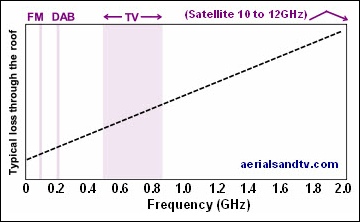
The roll off in an aerials sensitivity is far greater above the aerials designed for group than below it, see the gain curves below. For example a decent B group aerial will work reasonably well right down the A band (though not so much for cheapo types). But its response above the B group will only be significant up to around CH56. This roll off in signal gain (above the aerial’s designed for group) is not always a bad thing as it can be helpful in filtering out unwanted transmissions (e.g. 4G signals from 2013).
The WIDEBAND aerial works across the whole band, but not as well as a grouped aerial, particularly an A group aerial, in fact such is the widebands inferiority that there is no such thing as a “High Gain” wideband aerial for the A group frequencies, see A group curves. However, anyone aligned on a transmitter which has its output spread right across the band (and wants to pick up all the channels) has no option but to fit a wideband aerial. This situation changed in 2013 when the TV band was cut back to CH60, at that point a new group, the T Group, was introduced and became “the new wideband”. Most aerial manufacturers started selling aerials with alleged 4G rejection properties, in fact the Log 36 we sell has these, but in my view high gain widebands with "4G rejecting" tuning are a waste of time mainly because decent filter will work far better than any aerial tuning (apart from an A group ? ), but also because these so called anti 4G aerials are losing gain from the mid CH50s in order to have significantly negative gain at CH60 !
Anyway, the T group was a passing fad with the 700MHz clearance, because, from June 2022, there aren't any TV transmissions over CH48. Thus from that date a K group aerial will be “the new wideband” !
NOTE : After the 700MHz clearance wideband aerials, and T groups, will continue to work for most people, but a K group will work better for those in poor signal areas.
Possibly, even further into the future all transmissions may go down into the A group. It should be remembered that widebands, T groups and K groups will all still work even if the band does go A group, though obviously the Ks will work the best, the widebands the worst, and T groups in the middle.
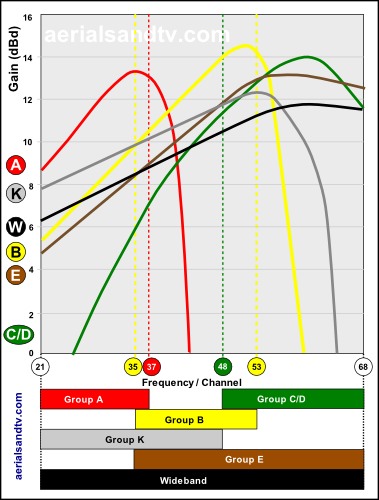
Graph of typical gain curves for “high gain” Yagi 18 element aerials
Notice the lower gain of the wideband antenna over the grouped aerials, and that this is particularly marked at the bottom of the band, i.e. group A.
The E group was a “semi wideband” aerial which sacrifices a bit of gain at the bottom so as to increase it at the middle and top end. It is now obsolete.
The K group is another "semi wideband" aerial which does not extend to the top of the (original) band so as to increase its gain in the middle and bottom end. BUT from June 2022 (when the temporary MUX7 was switched off) the K group is the new "wideband".
Note some Contract aerials can be very unpredictable in their gain curves, particularly out of their designed for bands.
For those who live in areas capable of reception from multiple transmitters the fact that a wideband can pick up right across the TV spectrum can, ironically, be a negative. This is partly because it gives more chance of co-channel on your system (if adding a modulated signal to it) but also because of the way some Freeview TVs scan for channels. If they find more than one of a particular MUX they will often put the first one they come across (which may not be the strongest) in the main selection position, leaving a more robust channel further up the menu or possibly ignoring it altogether. If you live in a strong reception area and some of your digital is fine, but some is not, it is always worth checking for this problem and most TVs can tell you which transmitter they’re picking up a particular channel from. This multi transmitter reception problem got worse after DSO, when the digital transmitting power was increased considerably, and Digital UK reckon up to 90% of homes suffer from some degree of “transmitter overlap”. This overlap is slightly more likely with wideband aerials because grouped aerials’ polar diagrams are tighter, similarly horizontally polarised aerials’ polar diagrams are tighter than vertically polarised ones.
If your box or TV gives you the option the simplest way round all this is to set your box to receives the correct region, or tune your box manually, but, unfortunately, not all TVs/STBs let you do this. So the next simplest solution (if your transmitter is A or B group) is to use a filter. Alternatively try pulling the aerial out of the TV, set the latter to tune, watch the tuning display closely, and only replace the aerial as it scans through the required part of the band. You could also try using an attenuator (only whilst the box is scanning) to tip the unwanted weaker transmissions down the digital cliff edge whilst leaving the required ones at the top. [link]
How Can I Tell If My Aerial Is Wideband ?
Knowing whether your aerial is a wideband could be important, either if you need a wideband to receive all the available channels, or, on the other hand, if you have the option to improve your signal by swapping from a wideband to a grouped aerial. A classic case of the latter being those on Crystal Palace transmitter who live in poor signal areas.
If your aerial was obtained from a non-specialist aerial retailer (e.g. B&Q or Screwfix) then it’s a wideband.
If your aerial is a Tri Boom or a 5 bay X beam then it's a wideband. If it's a Log Periodic it’s also likely to be a wideband.
If your aerial has black bung in the end of the boom (as opposed to a coloured bung) then it’s likely to be a wideband.
If the directors of your aerial are significantly smaller than the dipole then it’s a strong indication that it’s a wideband (see picture).
Also see lengths of grouped aerial elements.
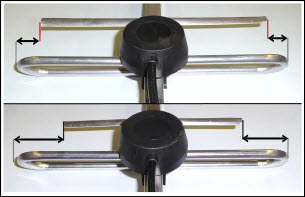
The frequency response of the aerial may well be stamped on it, this is often on the dipole.
How old is your aerial ? The older it is the, more likely to be a grouped aerial. Before the 1990s very few widebands were fitted (though I assume any DIY shed aerial must have been one ?).
If your transmitter is a wideband and you’re picking up all the channels, to a greater or lesser extent, then your aerial must be a wideband. Either that, or you live next to the transmitter ! A grouped aerial may not give any significant signal at all outside of its band.
History of the UHF TV aerial groups in Britain
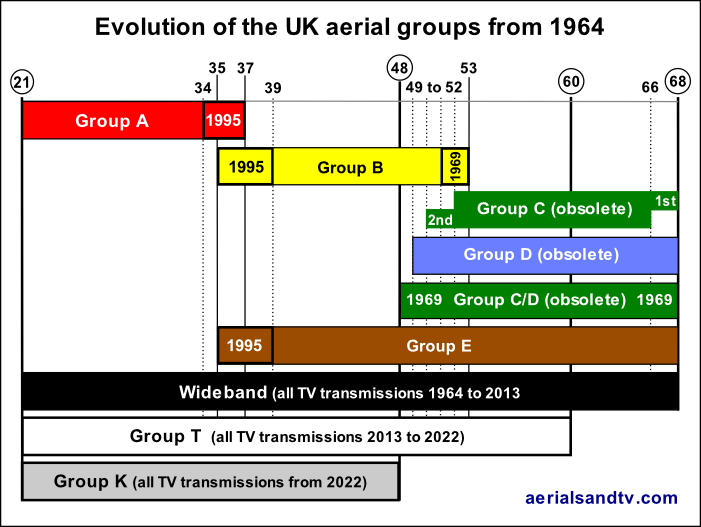
Notes : The dates of 1969 and 1995 (for the changes in the groups) are approximate. 1969 was the year that BBC1 and ITV joined BBC2 in being transmitted on UHF. Channel 5 began transmission on the 30th of March 1997, but planning for this had started years before this. A helpful contact in the aerial industry has informed me that the extending of the aerial groups was being undertaken 18 months to two years before the actual launch of C5, giving 1995. However aerials designed under the previous group designations would probably still have been on sale/being fitted months (or even years) after 1995.
One should always remember that grouped aerials frequency responses are approximate anyway, very approximate ! For instance, an E group is (was...) really a wideband with an emphasis on the top end frequencies. The K group needs clarification as well, particularly post switchover when there are a significant number of K group transmitters. The K technically finishes at CH48 so after the esoteric "temporary" MUXES 7 and 8 were switched off (in Jun 2022 and Jun 2020 respectively) the K group is, unequivocally, the new wideband.
When UHF TV transmissions began in 1964 the B group was CH39-CH51, but it has since been extended up to CH53. During my research for a definite date for this a helpful contact at Ofcom found a guide to TV transmitters dated 1974 and that had the B group up to CH53 so it must have changed prior to that date, possibly when BBC1 and ITV started UHF transmissions in 1969 ? Furthermore the "Practical Aerial Handbook" of 1970 seems to confirm that because it reports that the Radio and Electronic Component Manufacturers Federation have revised the aerial groups, Group B is now CH39 to CH53. The same article also states that group C/D was extended down from CH52-CH68 to CH48-CH68
The B group and the E group, were also extended down to CH35 (from CH39) around 1995 when the planning for C5 transmissions (from 1997) was beginning. At this same time group A was extended up from CH34 to CH37 because some group A transmitters (Crystal Palace being the most obvious example) were having to transmit C5 on CH37, though somewhat confusingly, in the case of Crystal Palace, it was actually transmitted from Croydon !
It must be said that extending aerial groups down a few channels is usually a bit irrelevant because Yagi antennas generally work pretty well below their designed for bands although some Contract type aerials [and some others without Baluns ? ] don’t always work quite as well as decent antennas.
The story of C/D.
I’m sure you’ve often wondered what is the story behind the C/D aerial group,
I know I have and I don’t think I’m autistic.
Well perhaps a little.
My wife reckons all men have autistic tendencies and I think she could be right. The question is, can you actually be autistic if you take the mickey out of yourself for being autistic ?
After pondering that little psychological question we can now move on to the origins of the C/D group.....
When UHF transmissions first started in 1964 the C group was CH52 to CH68, it was later changed to CH50 to 66 though some sources state it was CH60 from the beginning ! However an additional D group (blue bung) was also added which was CH49 to CH68. I can’t imagine there’d be much difference between aerials of those three groups but there we go. Finally in 1969 the C and D groups were amalgamated into one, the C/D group at CH48 to CH68, though some sources still talk about them separately as late as 1974.
Addition of the T group : The latest (but quite possibly not the last) change to the aerial groups is the addition of the T group in 2013. This is effectively a truncated wideband which is a first in that up to now, in our little history lesson, all has been about extending not truncating ! Anyway, this pruning of the wideband is to allow for the fact that from July 2013 onwards there are no TV transmissions over CH60. That part of the spectrum having been sold off for 4G mobile phone use. Now those transmissions may well cause problems with TV reception so it’s actually preferable to have an aerial which doesn’t pick up over CH60. Isn’t it funny how the old ways (in this case aerial groups, specifically A, B & K) are often found to be the best in the end !
In October 2016 Ofcom confirmed that the 700MHz clearance would take place by the second quarter of 2020. That is to say clearing all TV transmissions between CHs 49 and 60. I believe this may herald the start of a long road to complete cessation of terrestrial transmissions though it remains to be seen how long that will take, it would be a very brave (read suicidal) politician who announced the death of TV reception through your aerial ! But back to what we do know, the 700MHz clearance is effectively the death of the C/D group, which is a bit sad actually……
There are rumours that in the future TV transmissions may eventually be restricted even further, possibly into just the A group. Fortunately all (decent) grouped aerials (apart from C/Ds) still work down at CH21 so, to be frank, I wouldn’t worry about these potential changes too much.
As the TV frequencies are moved down the band (more accurately compressed down the band….), it should be remembered that signals of lower frequency travel more efficiently than those of higher frequency. This can mean that signals of borderline quality before, can become more reliable, particularly if they all fall within the A group, provided, of course, you’re using an aerial tuned to pick them up efficiently, i.e. an A group !

